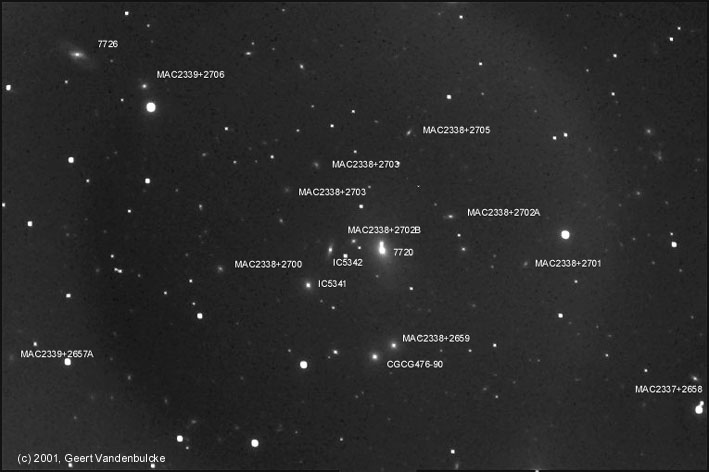
Pegasus Cluster II.
During the night of 16 – 17 December 2001, while looking in the program "The Sky" my attention was drawn to an object called "Pegasus Cluster II". I did not know this object and wanted to try and image it with my C14 and ST-8 (non-E, ABG). I made three exposures of 30 minutes each. Next day, I reduced the images but found that my flat field image was unusable, leaving quite a gradient in the image. I left the image untouched until February 2002. I had improved on my flatfield technique and since I tend to work to some standard, I could use a new flat field image that corrected the image somewhat better, but still not perfect. I have labelled the objects that I can identify in "Megastar", numbers without a prefix are NGC-objects. There are a lot of faint galaxies in the image, I could not find more information in "Burnham’s" or in "The Night Sky Observer’s Guide". In the "Deep Sky Field Guide to Uranometria 2000.0" NGC7720 is listed as magnitude 12.3, NGC7726 is 14.6. According to "The Sky" IC5342 is magnitude 15.6. There is a difference between the data in "Megastar" and "The Sky": the galaxy NGC7726 ("Megastar") is listed as UGC12721 in "The Sky" while IC5342 ("Megastar") is given the name NGC7726 in "The Sky". I am surprised with this image, made from a quite lightpolluted sky and with bad seeing!

| Object | Pegasus Cluster II |
| Date | 16-17 December 2001 |
| Exposure Time | 3 x 30 m |
| Observing From | Oostduinkerke, Belgium. |
| Telescope | Celestron 14 @ f/6.3 |
| Camera | SBIG ST-8, 2x2 binning, -15°C |
| Accessories | Alan Gee II compressor, CFW8 clear filter |
| Acquisition Software | CCDSOFT V5 |
| Image Processing Software | AstroArt, Photoshop |
| Conditions | FWHM 6 to 7", light pollution |
| Film | --- |